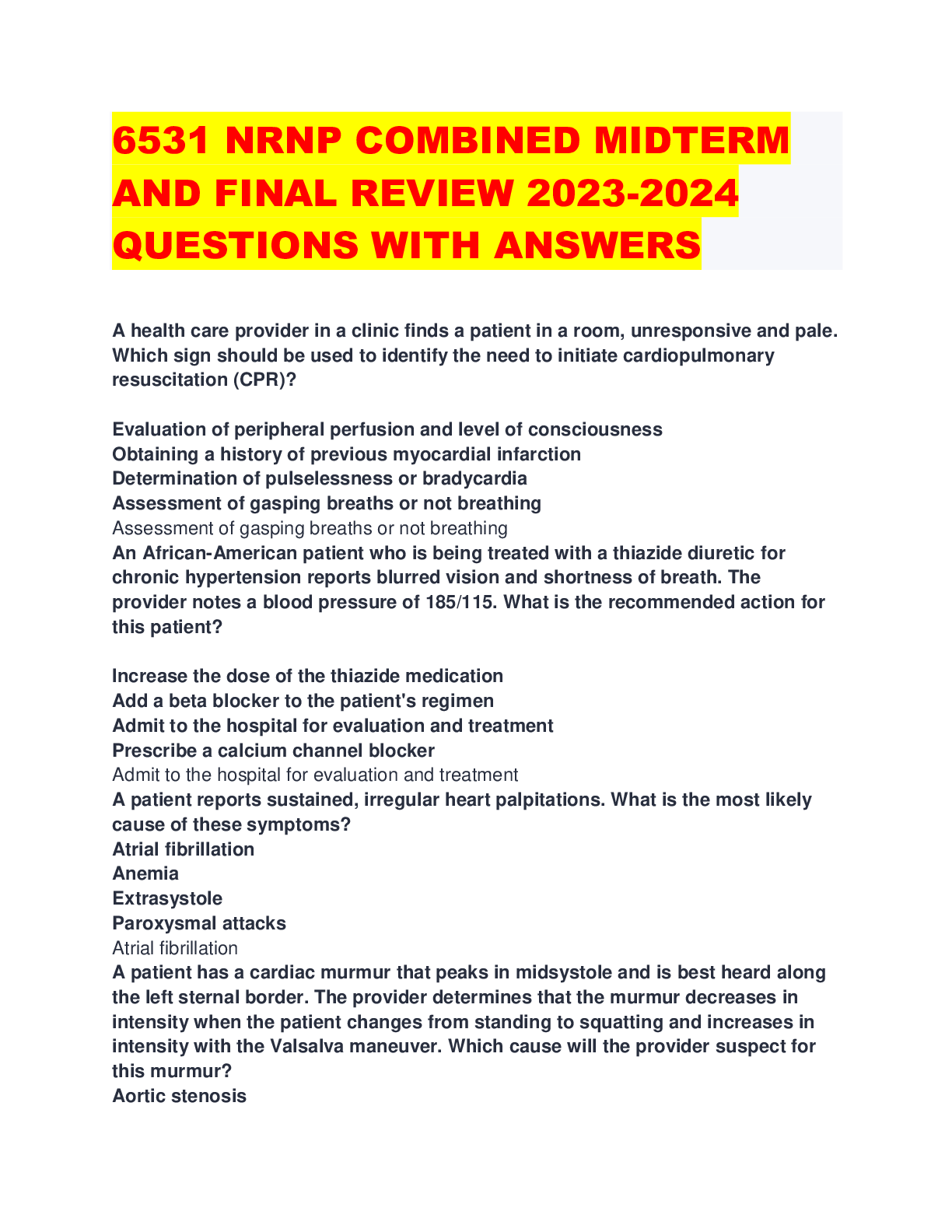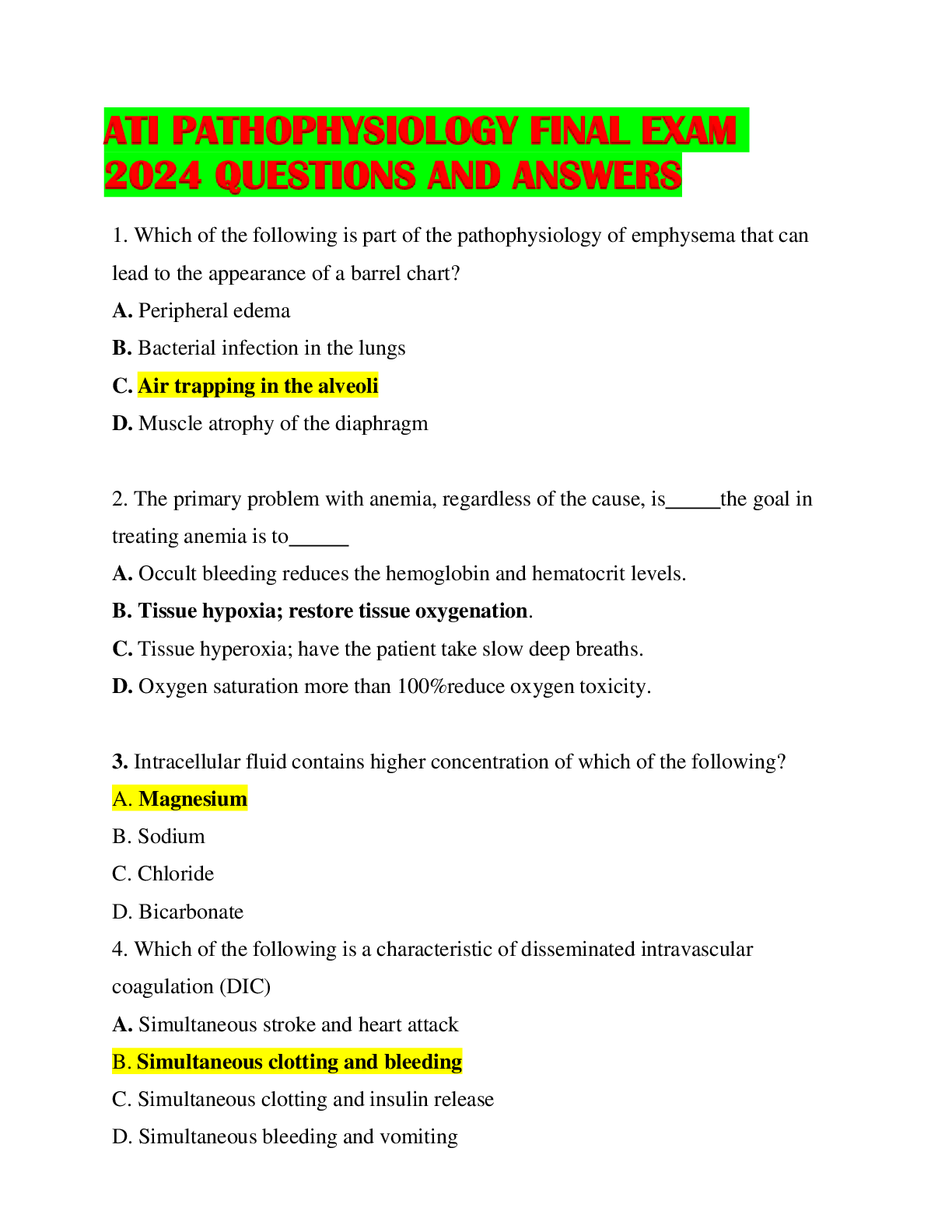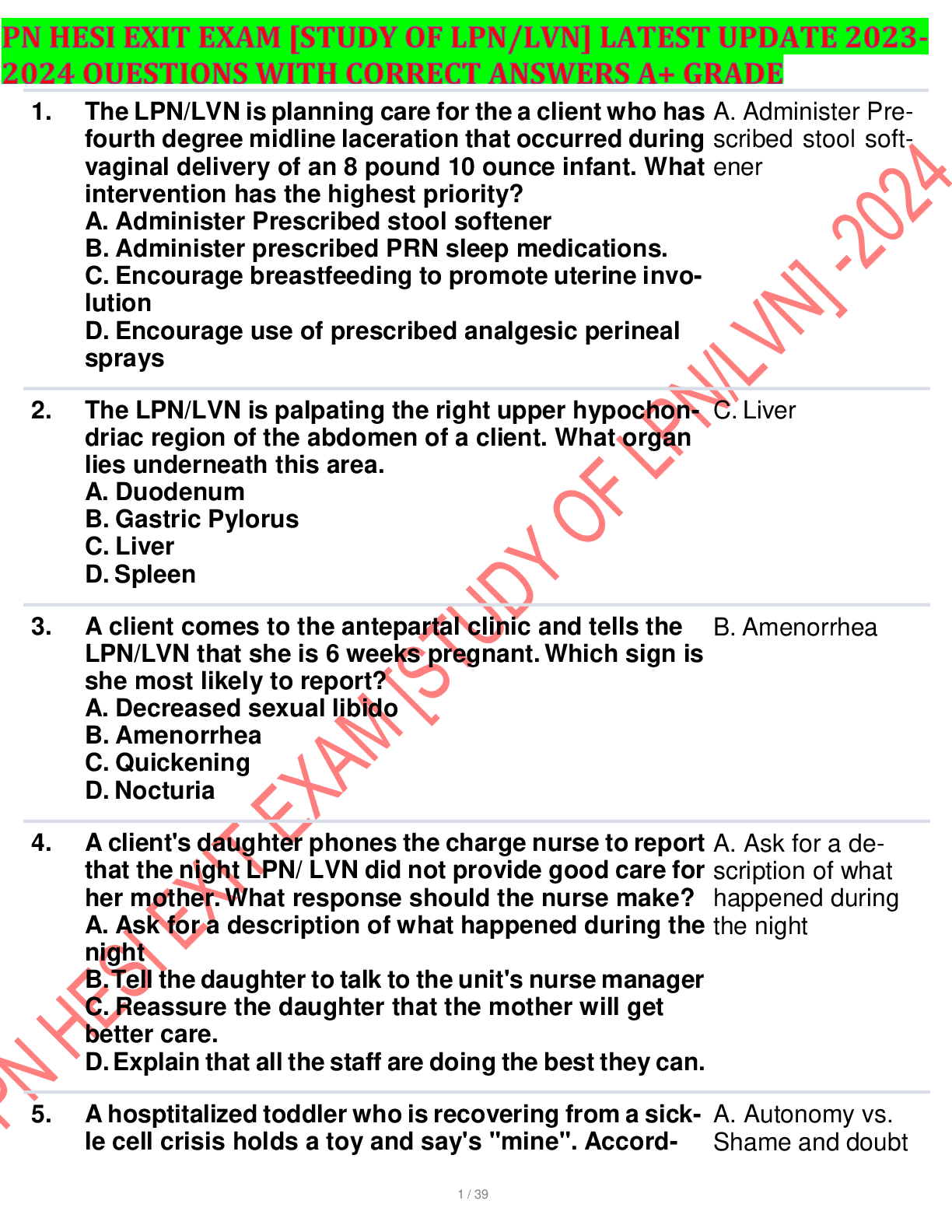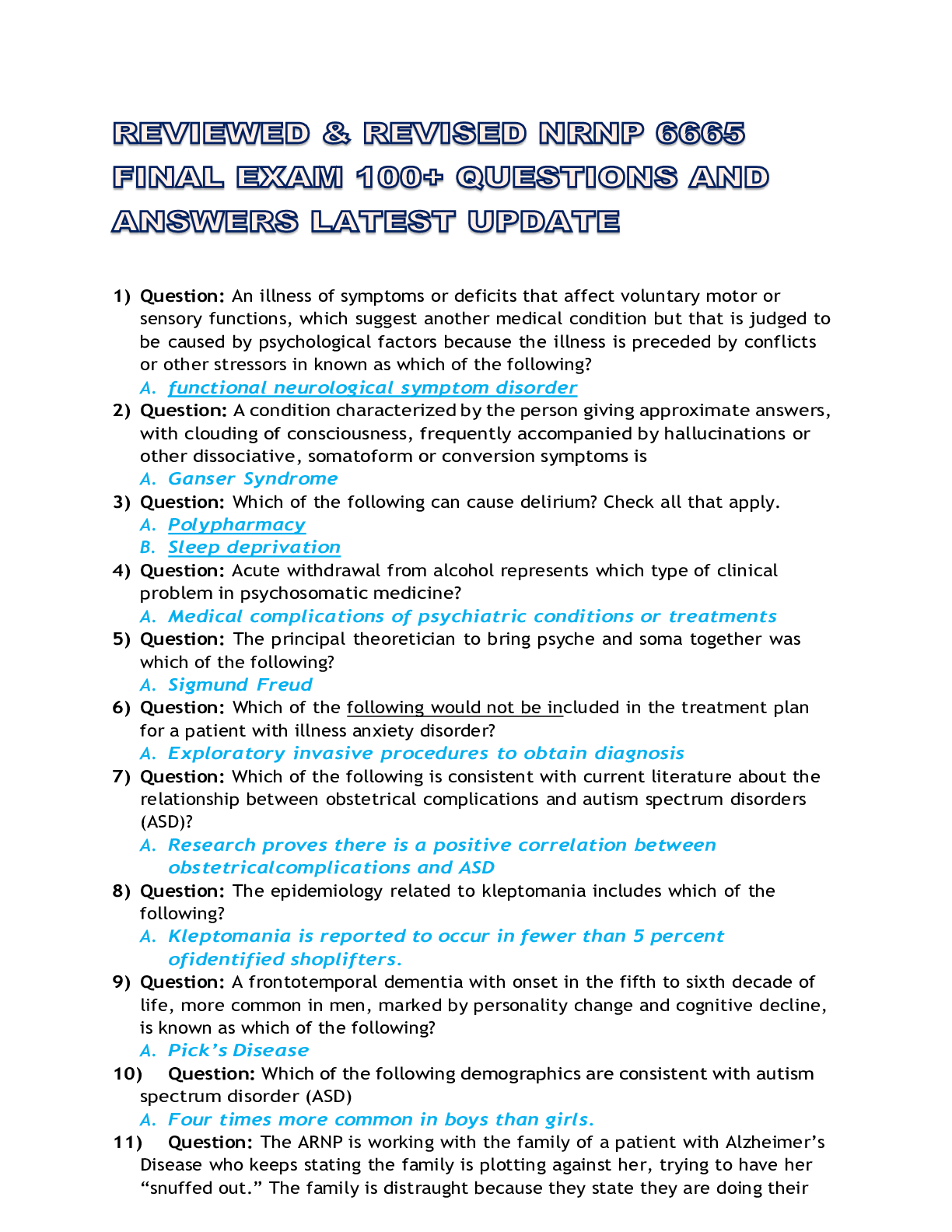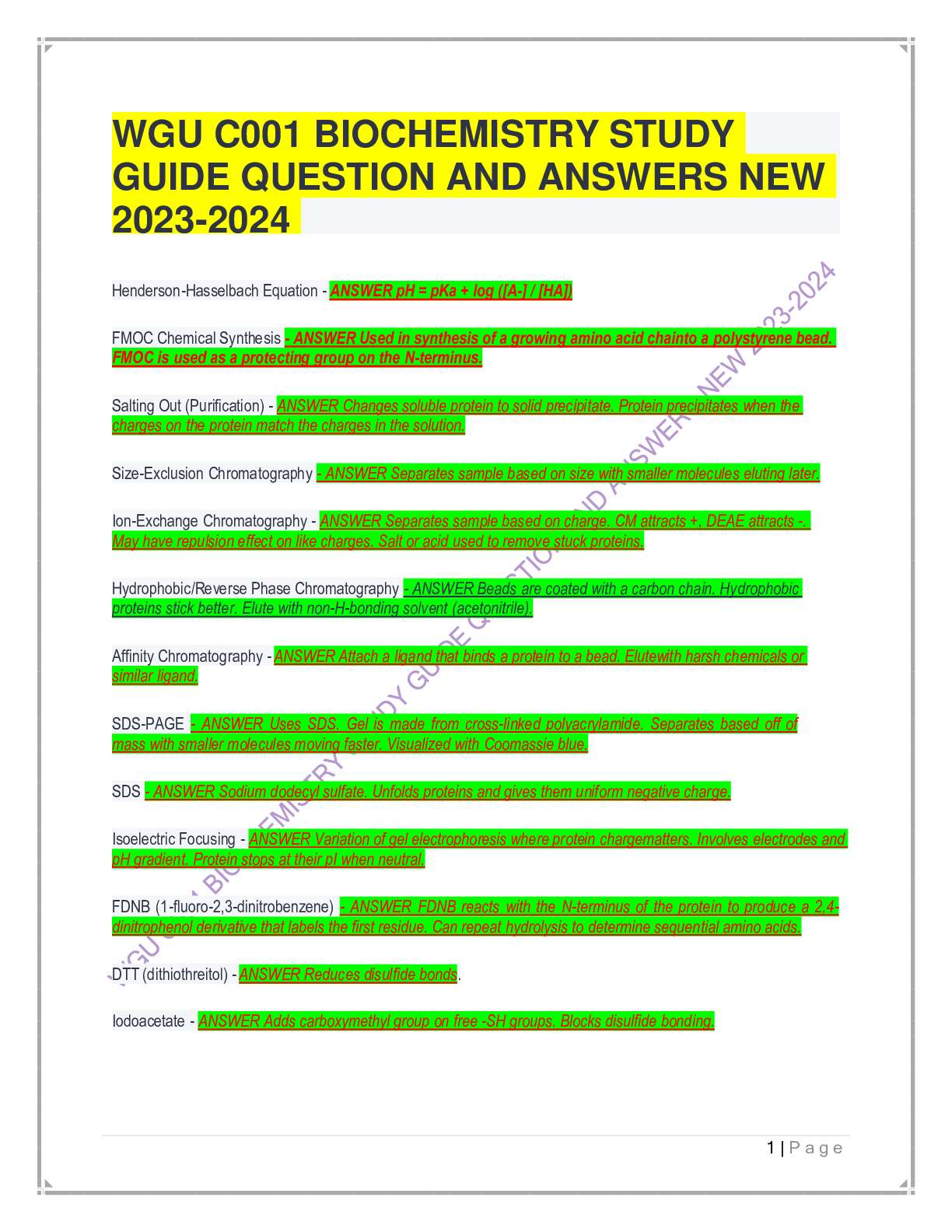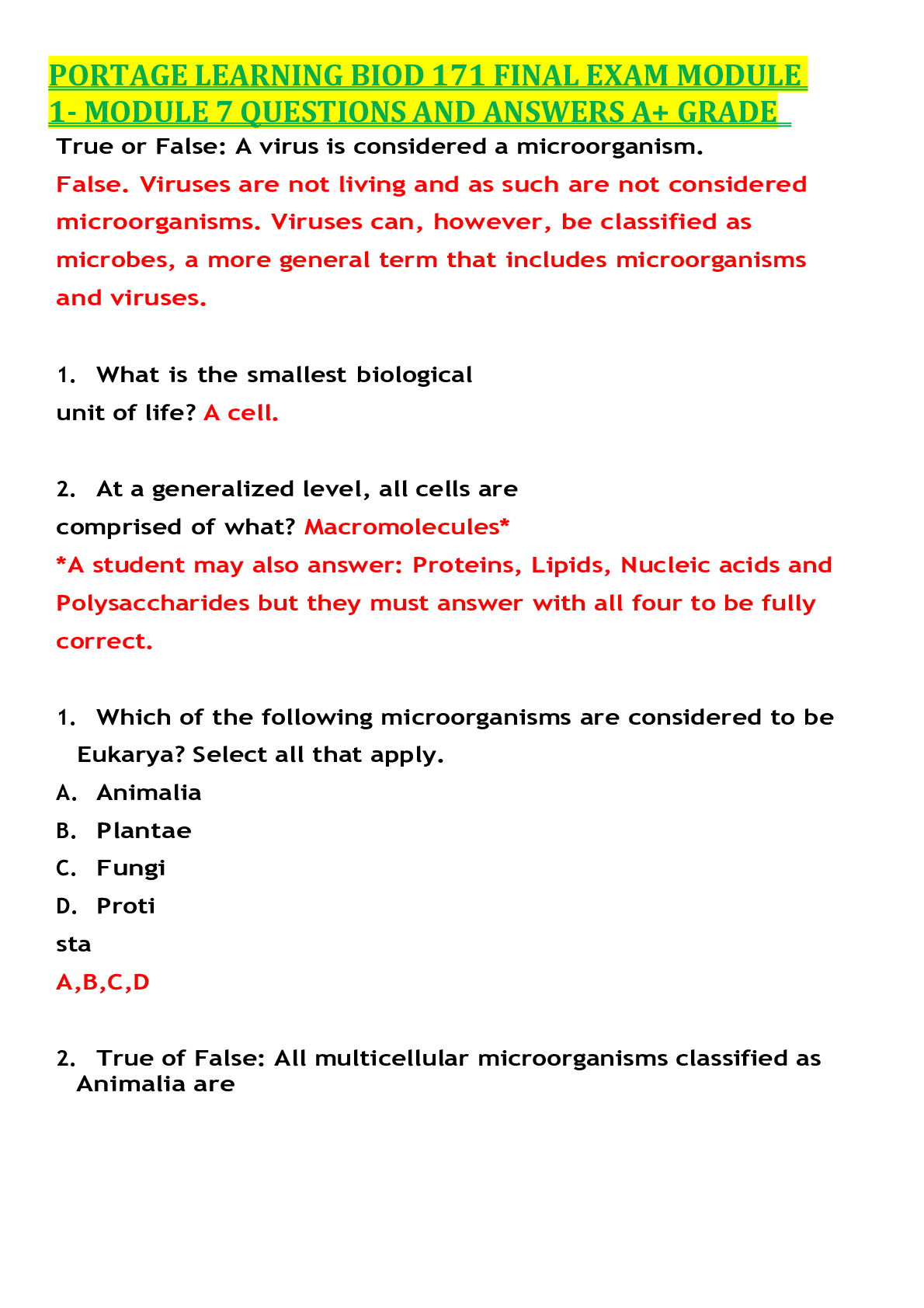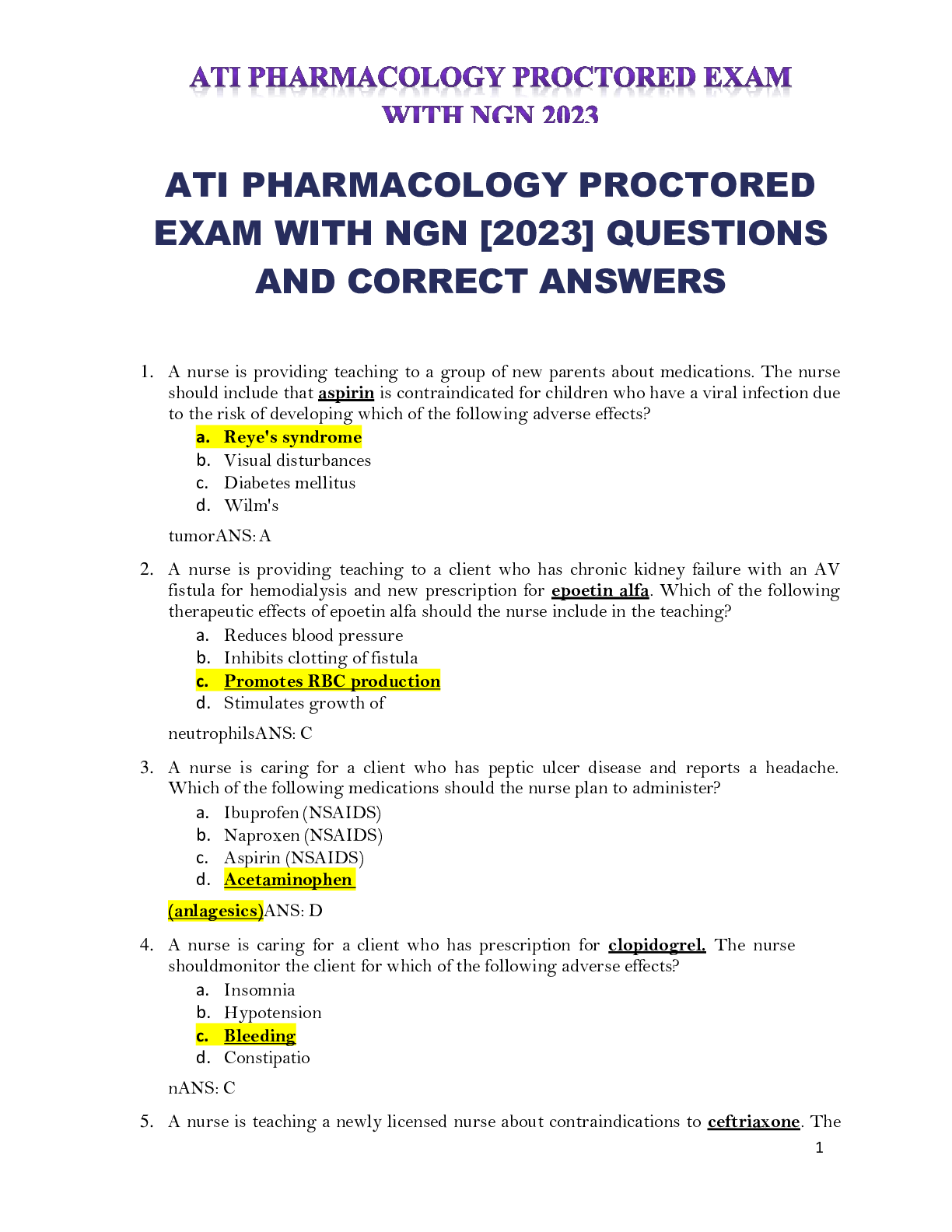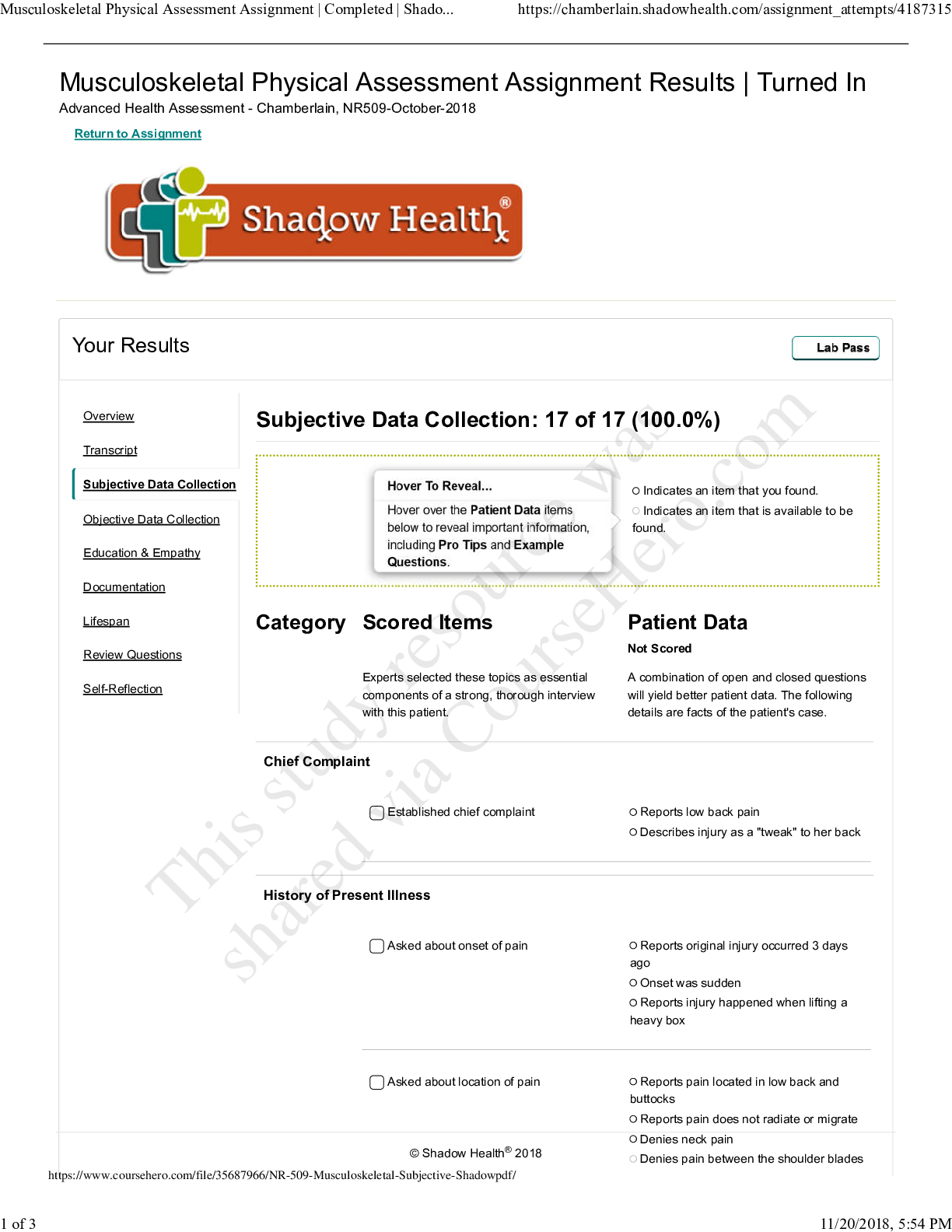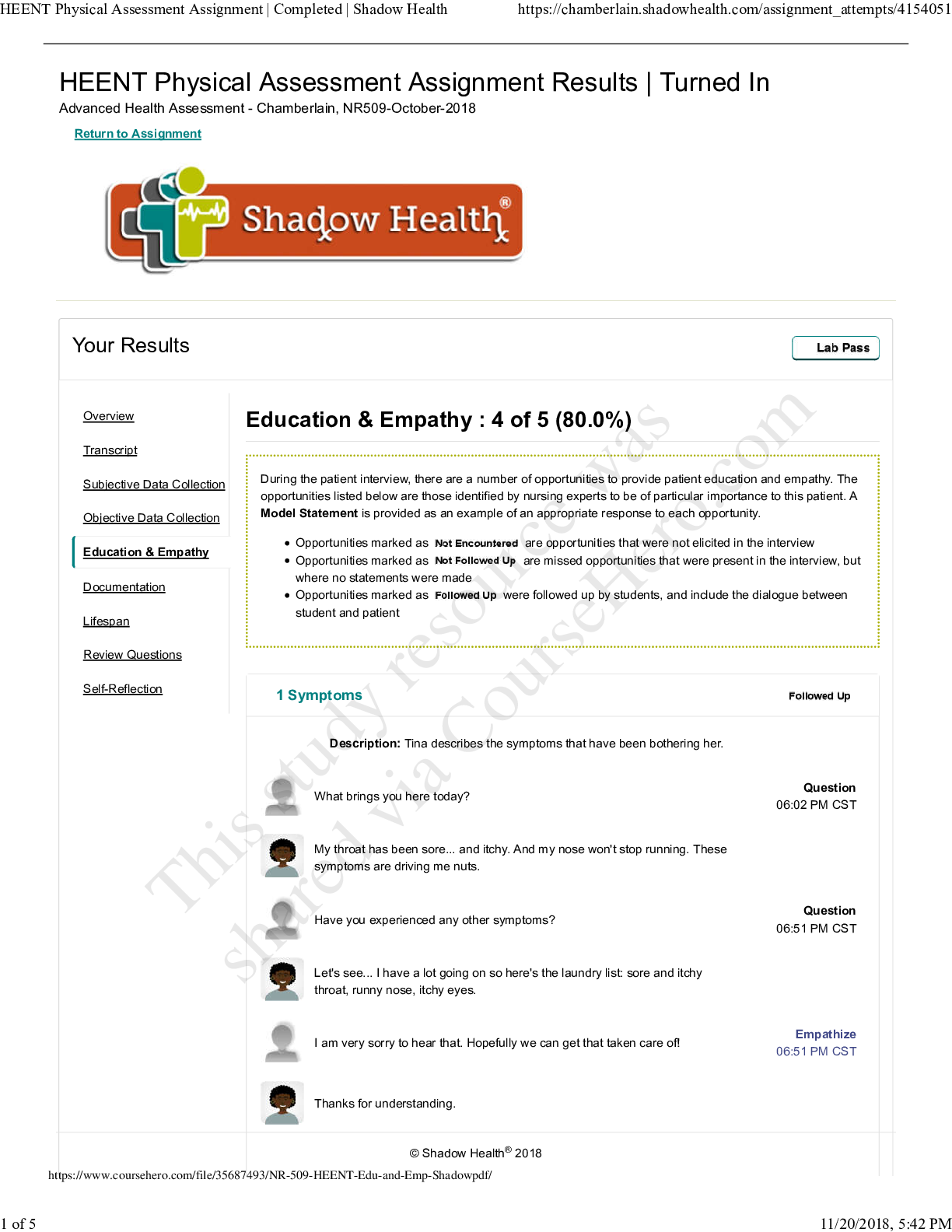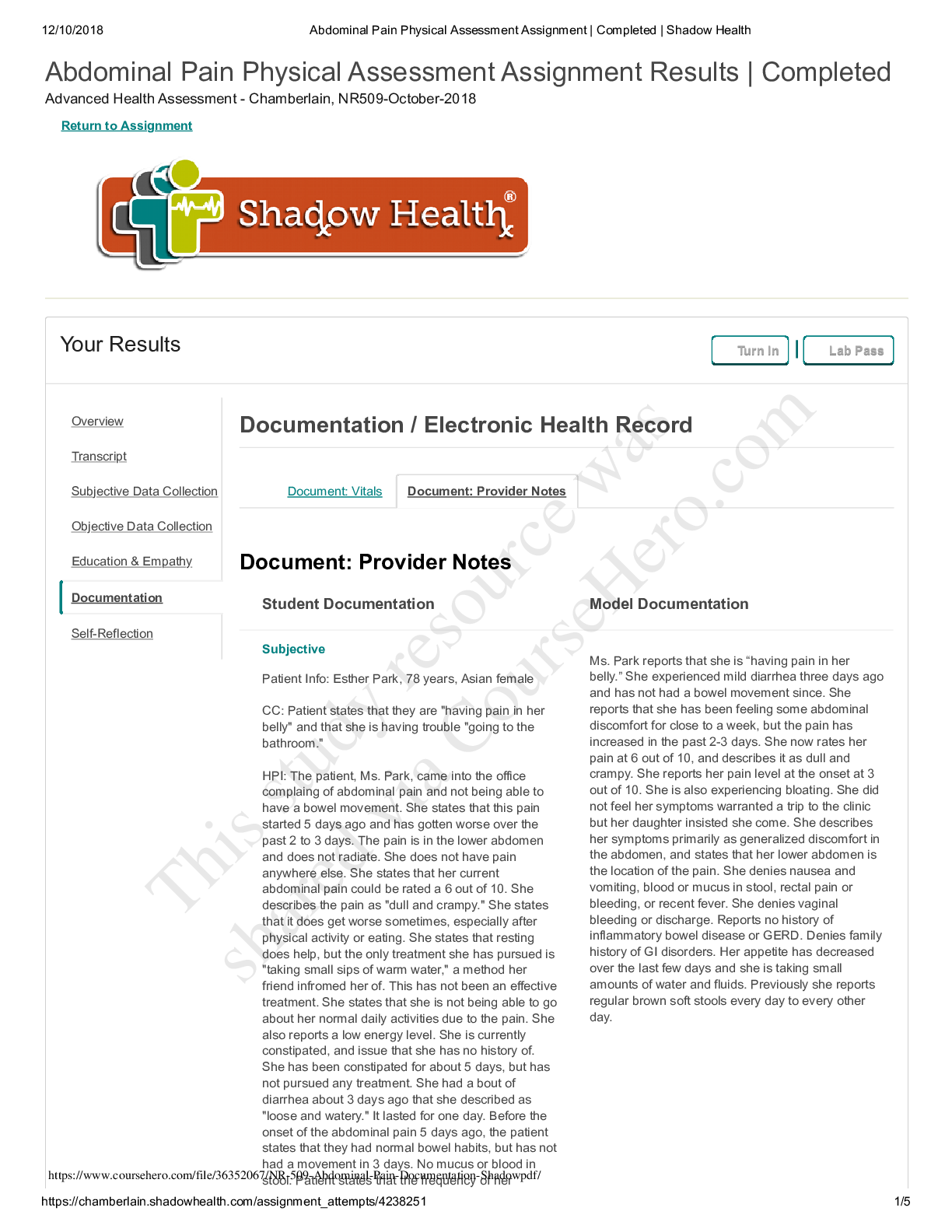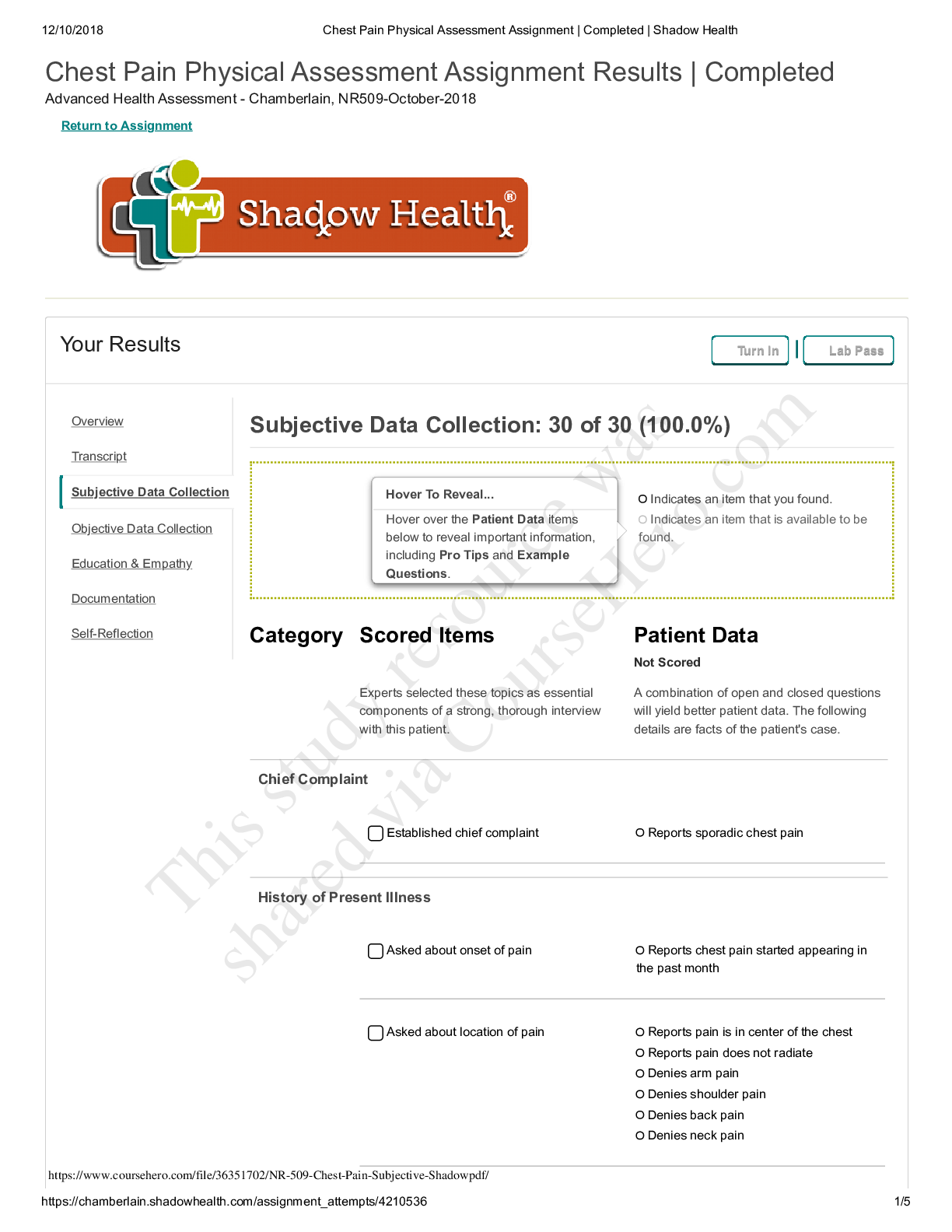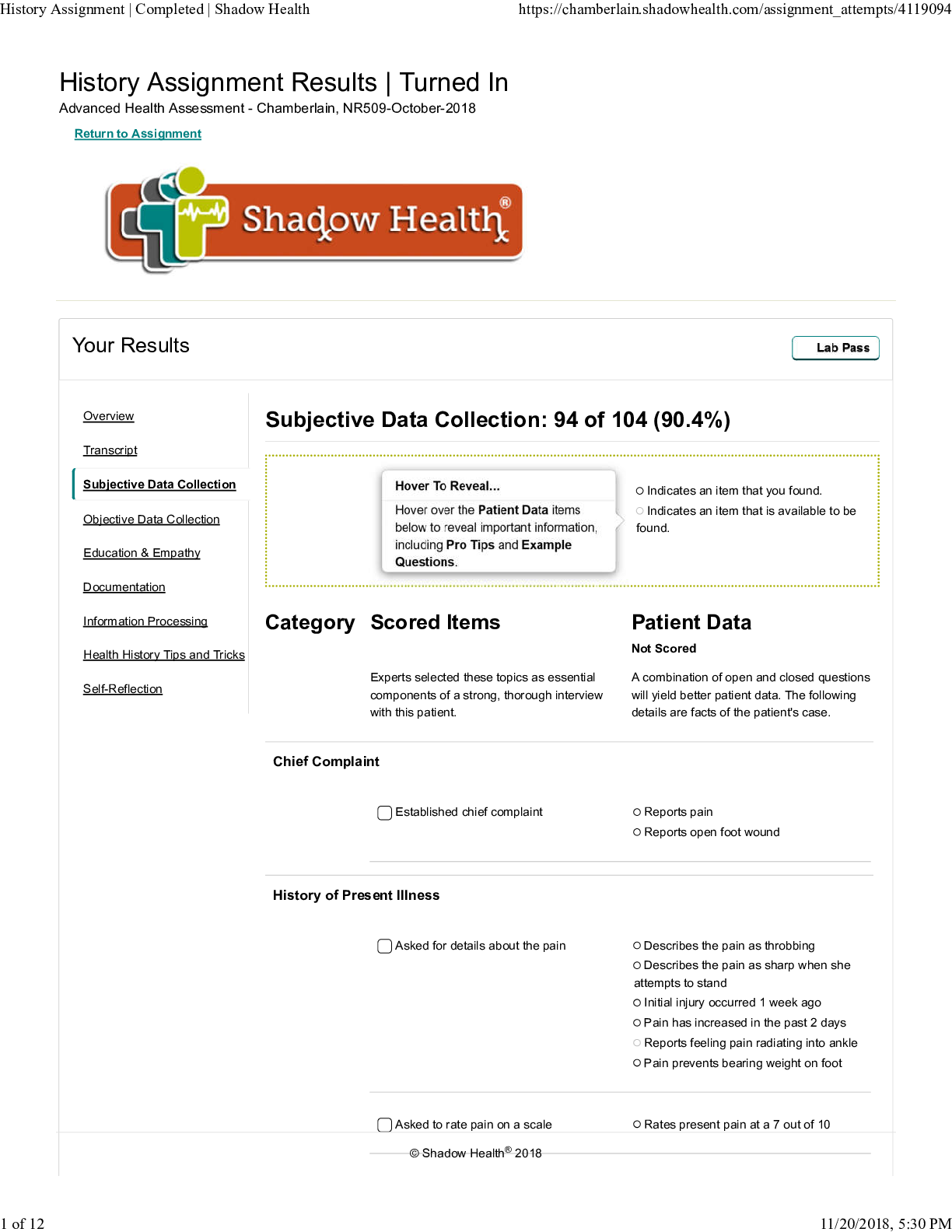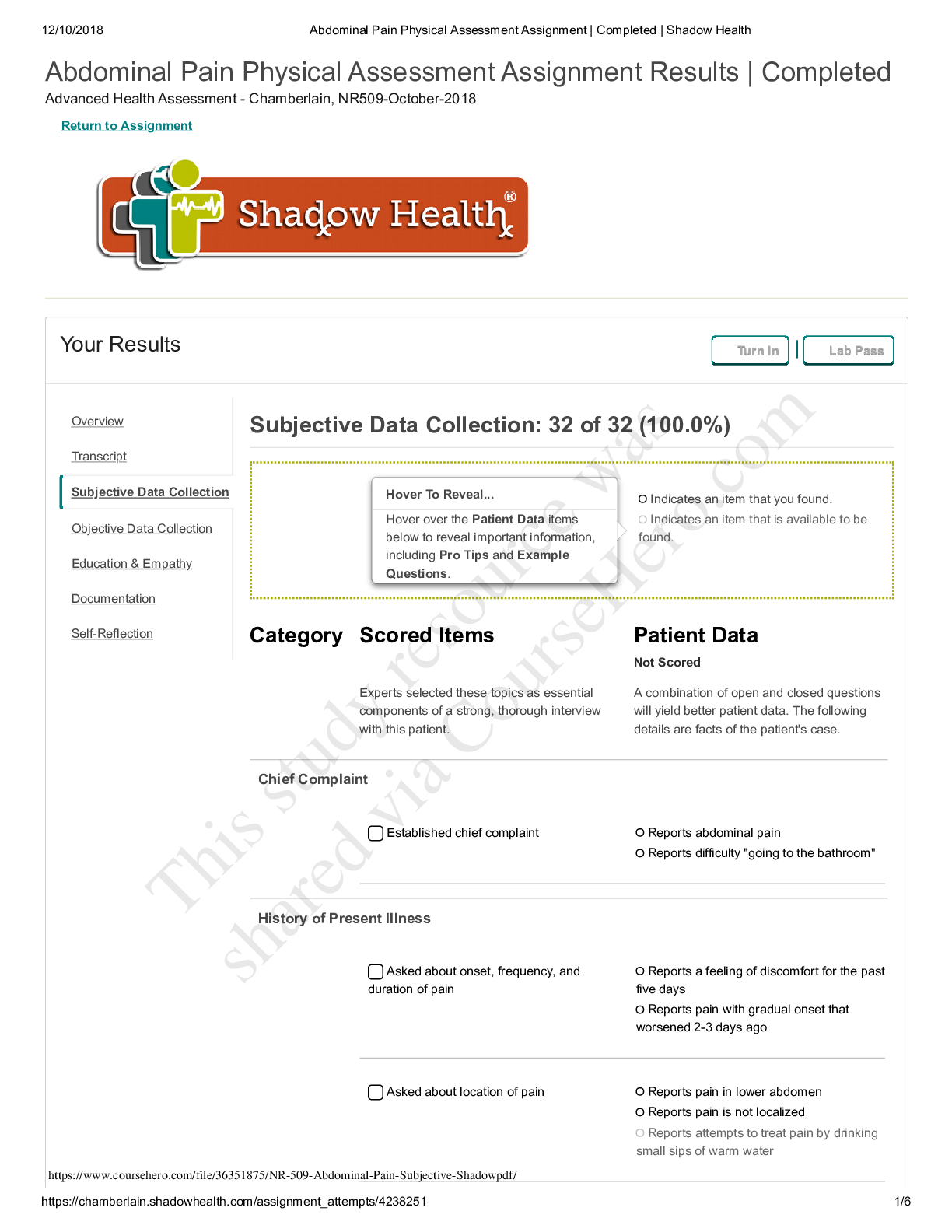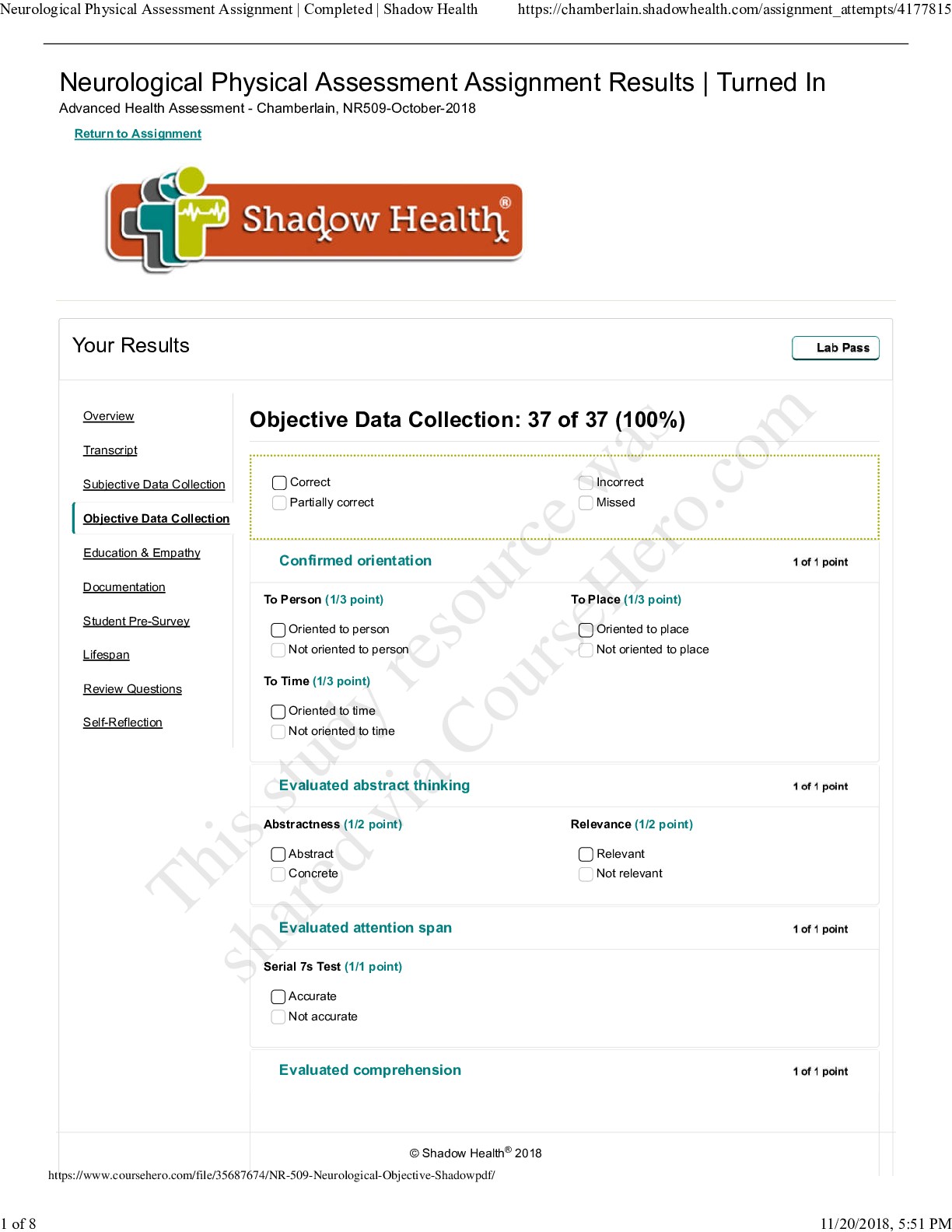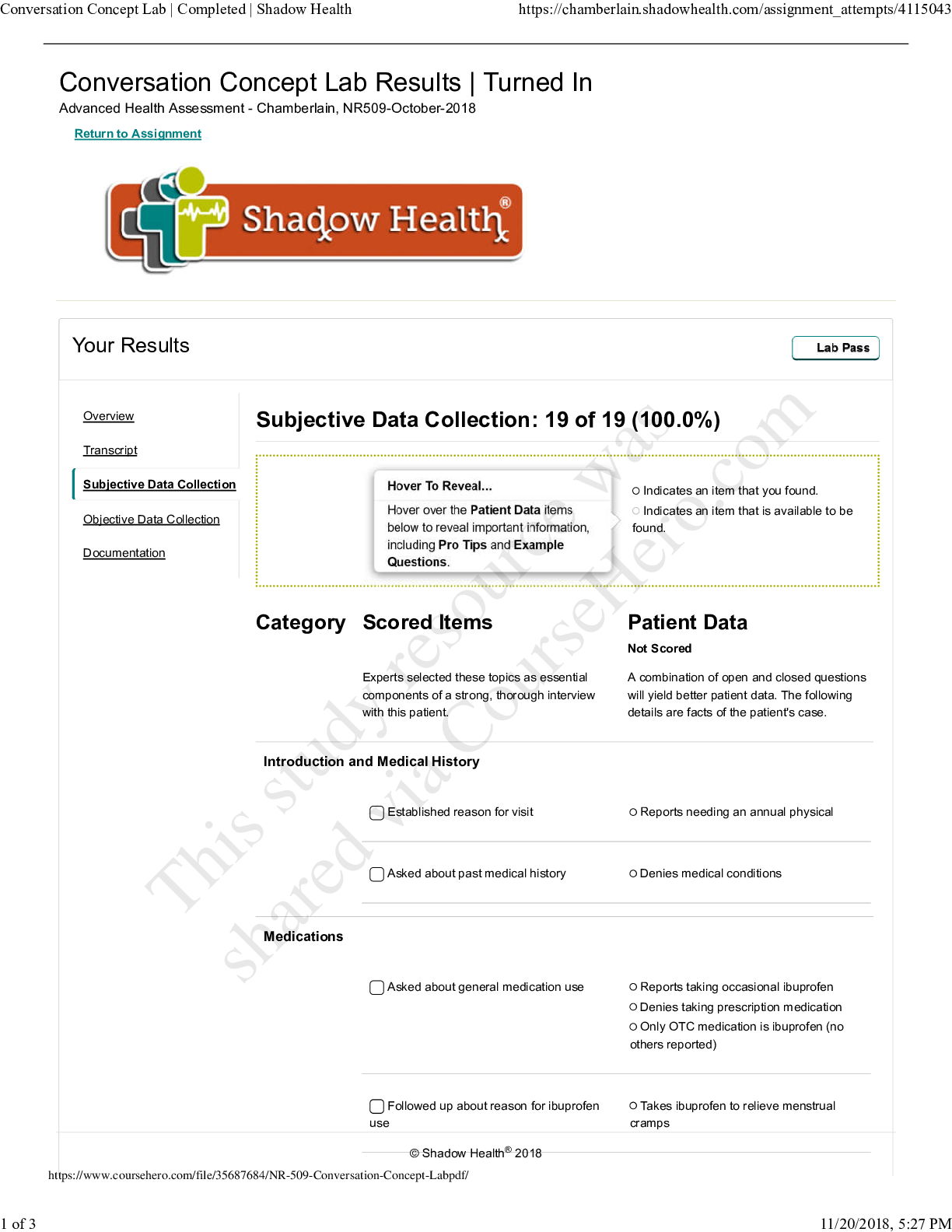Health Care > EXAM > HESI MATERNITY EXAM 20 LATEST VERSIONS VERIFIED QUESTIONS AND ANSWERS 100 % SATISFACTION GUARANTEED (All)
HESI MATERNITY EXAM 20 LATEST VERSIONS VERIFIED QUESTIONS AND ANSWERS 100 % SATISFACTION GUARANTEED
Document Content and Description Below
HESI MATERNITY EXAM 20 LATEST VERSIONS VERIFIED QUESTIONS AND ANSWERS 100 % SATISFACTION GUARANTEED HESI Maternity 1) At 14-weeks gestation, a client arrives at the Emergency Center complai... ning of a dull pain in the right lower quadrant of her abdomen. The LPN/LVN obtains a blood sample and initiates an IV. Thirty minutes after admission, the client reports feeling a sharp abdominal pain and a shoulder pain. Assessment findings include diaphoresis, a heart rate of 120 beats/minute, and a blood pressure of 86/48. Which action should the nurse implement next? A. Check the hematocrit results. B. Administer pain medication. C. Increase the rate of IV fluids. D. Monitor client for contractions. Correct Answer: C 2) During a prenatal visit, the LPN/LVN discusses with a client the effects of smoking on the fetus. When compared with nonsmokers, mothers who smoke during pregnancy tend to produce infants who have A. lower Apgar scores. B. lower birth weights. C. respiratory distress. D. a higher rate of congenital anomalies. Correct Answer: D 3) Which action should the LPN/LVN implement when preparing to measure the fundal height of a pregnant client? A. Have the client empty her bladder. B. Request the client lie on her left side. C. Perform Leopold's maneuvers first. D. Give the client some cold juice to drink. Correct Answer:A 4) The LPN/LVN identifies crepitus when examining the chest of a newborn who was delivered vaginally. Which further assessment should the nurse perform? A. Elicit a positive scarf sign on the affected side. B. Observe for an asymmetrical Moro (startle) reflex. C. Watch for swelling of fingers on the affected side. D. Note paralysis of affected extremity and muscles. Correct Answer: B 5) One hour after giving birth to an 8-pound infant, a client's lochia rubra has increased from small to large and her fundus is boggy despite massage. The client's pulse is 84 beats/minute and blood pressure is 156/96. The healthcare provider prescribes Methergine 0.2 mg IM Å~ 1. What action should the LPN/LVN take immediately? A. Give the medication as prescribed and monitor for efficacy. B. Encourage the client to breastfeed rather than bottle feed. C. Have the client empty her bladder and massage the fundus. D. Call the healthcare provider to question the prescription. Correct Answer: D 6) The LPN/LVN is preparing to give an enema to a laboring client. Which client requires the most caution when carrying out this procedure? A. A gravida 6, para 5 who is 38 years of age and in early labor. B. A 37-week primigravida who presents at 100% effacement, 3 cm cervical dilatation, and a -1 station. C. A gravida 2, para 1 who is at 1 cm cervical dilatation and a 0 station admitted for induction of labor due to post dates. D. A 40-week primigravida who is at 6 cm cervical dilatation and the presenting part is not engaged. Correct Answer:D 7) A client at 32-weeks gestation comes to the prenatal clinic with complaints of pedal edema, dyspnea, fatigue, and a moist cough. Which question is most important for the LPN/LVN to ask this client? A. Which symptom did you experience first? B. Are you eating large amounts of salty foods? C. Have you visited a foreign country recently? D. Do you have a history of rheumatic fever? Correct Answer: D 8) The LPN/LVN is assessing a client who is having a non-stress test (NST) at 41- weeks gestation. The nurse determines that the client is not having contractions, the fetal heart rate (FHR) baseline is 144 bpm, and no FHR accelerations are occurring. What action should the nurse take? A. Check the client for urinary bladder distention. B. Notify the healthcare provider of the nonreactive results. C. Have the mother stimulate the fetus to move. D. Ask the client if she has felt any fetal movement. Correct Answer: D 9) A client in active labor is admitted with preeclampsia. Which assessment finding is most significant in planning this client's care? A. Patellar reflex 4+ B. Blood pressure 158/80. C. Four-hour urine output 240 ml. D. Respiration 12/minute. Correct Answer: A 10) The LPN/LVN assesses a client admitted to the labor and delivery unit and obtains the following data: dark red vaginal bleeding, uterus slightly tense between contractions, BP 110/68, FHR 110 beats/minute, cervix 1 cm dilated and uneffaced. Based on these assessment findings, what intervention should the nurse implement? A. Insert an internal fetal monitor. B. Assess for cervical changes q1h. C. Monitor bleeding from IV sites. D. Perform Leopold's maneuvers. Correct Answer: C 11) A client at 32-weeks gestation is diagnosed with preeclampsia. Which assessment finding is most indicative of an impending convulsion? A. 3+ deep tendon reflexes and hyperclonus. B. Periorbital edema, flashing lights, and aura. C. Epigastric pain in the third trimester. D. Recent decreased urinary output. Correct Answer: A 12) Immediately after birth a newborn infant is suctioned, dried, and placed under a radiant warmer. The infant has spontaneous respirations and the nurse assesses an apical heart rate of 80 beats/minute and respirations of 20 breaths/ minute. What action should the LPN/LVN perform next? A. Initiate positive pressure ventilation. B. Intervene after the one minute Apgar is assessed. C. Initiate CPR on the infant. D. Assess the infant's blood glucose level. Correct Answer: A 13) A pregnant woman comes to the prenatal clinic for an initial visit. In reviewing her childbearing history, the client indicates that she has delivered premature twins, one full-term baby, and has had no abortions. Which GTPAL should the LPN/LVN document in this client's record? A. 3-1-2-0-3. B. 4-1-2-0-3. C. 2-1-2-1-2. D. 3-1-1-0-3. Correct Answer: D 14) The healthcare provider prescribes terbutaline (Brethine) for a client in preterm labor. Before initiating this prescription, it is most important for the LPN/LVN to assess the client for which condition? A. Gestational diabetes. B. Elevated blood pressure. C. Urinary tract infection. D. Swelling in lower extremities. Correct Answer: A 15) A 4-week-old premature infant has been receiving epoetin alfa (Epogen) for the last three weeks. Which assessment finding indicates to the LPN/LVN that the drug is effective? A. Slowly increasing urinary output over the last week. B. Respiratory rate changes from the 40s to the 60s. C. Changes in apical heart rate from the 180s to the 140s. D. Change in indirect bilirubin from 12 mg/dl to 8 mg/dl. Correct Answer: C 16) The nurse is providing discharge teaching for a client who is 24 hours postpartum. The nurse explains to the client that her vaginal discharge will change from red to pink and then to white. The client asks, "What if I start having red bleeding after it changes?" What should the nurse instruct the client to do? A. Reduce activity level and notify the healthcare provider. B. Go to bed and assume a knee-chest position. C. Massage the uterus and go to the emergency room. D. Do not worry as this is a normal occurrence. Correct Answer: A 17) A couple has been trying to conceive for nine months without success. Which information obtained from the clients is most likely to have an impact on the couple's ability to conceive a child? A. Exercise regimen of both partners includes running four miles each morning. B. History of having sexual intercourse 2 to 3 times per week. C. The woman's menstrual period occurs every 35 days. D. They use lubricants with each sexual encounter to decrease friction. Correct Answer: D 18) A pregnant client tells the LPN/LVN that the first day of her last menstrual period was August 2, 2006. Based on Nägele's rule, what is the estimated date of delivery? A. April 25, 2007. B. May 9, 2007. C. May 29, 2007. D. June 2, 2007. Correct Answer: B 19) A client with no prenatal care arrives at the labor unit screaming, "The baby is coming!" The nurse performs a vaginal examination that reveals the cervix is 3 centimeters dilated and 75% effaced. What additional information is most important for the LPN/LVN to obtain? A. Gravidity and parity. B. Time and amount of last oral intake. C. Date of last normal menstrual period. D. Frequency and intensity of contractions. Correct Answer: C 20) The LPN/LVN is preparing a client with a term pregnancy who is in active labor for an amniotomy. What equipment should the nurse have available at the client's bedside? (Select all that apply.) A. Litmus paper. B. Fetal scalp electrode. [Show More]
Last updated: 3 months ago
Preview 1 out of 345 pages
Instant download

Buy this document to get the full access instantly
Instant Download Access after purchase
Add to cartInstant download
Reviews( 0 )
Document information
Connected school, study & course
About the document
Uploaded On
Mar 06, 2024
Number of pages
345
Written in
Additional information
This document has been written for:
Uploaded
Mar 06, 2024
Downloads
0
Views
5

